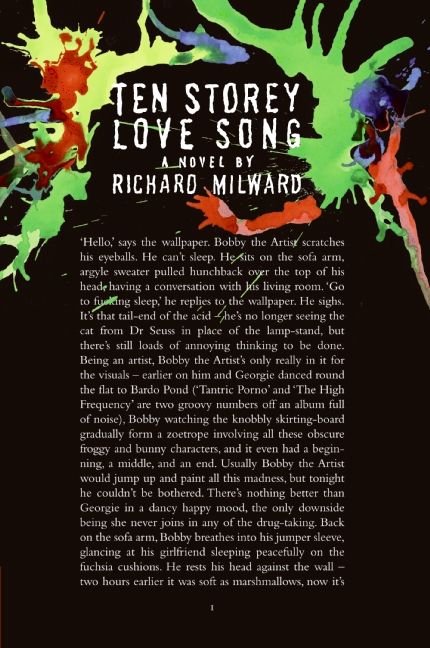
I was first attracted to Ten Storey Love Song because it began on the cover and continued to the end as a single 286 page paragraph – a quiet challenge to our assumption of what a book should look and read like. Add to that the comparison to Irvine Welsh, and it garnered a place on my floor-to-ceiling books-to-read pile. In fact, TSLS gets more than a comparison to Irvine Welsh; it gets some serious loving from the master himself. See his review in the Guardian. But I wouldn’t hold too strictly to the comparison. While both authors write the holy triumvirate of sex, drugs and rock & roll, with an emphasis on drugs, and while both create colourful casts of mostly young alienated men, Milward doesn’t exploit dialect to the same extent, using a more straight-up narrative voice and saving his northernisms for dialogue.
Perhaps it would be more apt to compare TSLS to John Niven’s Kill Your Friends, the story of Stelfox, an amoral music industry A & R (artist & repertoire) man whose career is a coke-fueled roller-coaster ride that sees him pushing talentless Spice Girl look-alikes into the limelight. I draw the comparison because Milward’s tale concerns the similarly drug-addled rush of Bobby the Artist into the limelight of the London gallery scene when a gallery owner’s sister inadvertently notices a discarded painting sitting in the stairwell of Peach House, the ten storey council flat in Middlesbrough where Bobby the Artist lives and paints. What Niven does to the music industry, Milward does to the world of art, exposing it as largely vacuous and corrupt. While Milward gives us no reason to suppose Bobby the Artist doesn’t have talent, he does give us reason to suppose that his fleeting brush with critical acclaim and financial success is as arbitrary as the latest boy band’s position on the top-40 play list.
The painting which first garners attention is a study of Bobby the Artist’s girlfriend and muse, Georgie, who is pictured sitting on their toilet: ”Georgie on the Toilet” (60x80cm). High art in low places? That is a lingering question throughout the novel. The characters seem fated to lead abysmal lives, but strangely succeed and find fulfilling relationships. The chronically depressed mother finds her darkness miraculously lifted by a new medication (which Bobby subsequently discovers is ecstasy). Is this a kind of back-handed redemption through drugs? Bobby has always hoped that Georgie, whose greatest addiction is to sugar candy, “could be weaned onto drugs”, an amusing reversal which Georgie throws back in Bobby’s face by substituting sugar powder and candies for the drugs he uses to overdose.
Also living in Peach House is Johnnie, Bobby’s best friend and source for drugs. Johnnie is a small time thief, small time dealer and a pathetic lover. He loves Ellen and Ellen loves him, but all he knows about intimacy with women he learned from his porn videos which explains why, for all her love, Ellen dreads sex with Johnnie. Inevitably, Ellen finds herself in the bed of another Peach House resident, Angelo Bashini. When Johnnie finds out, he puts Angelo in the hospital, compensating with rage for his failure in bed. However, as the novel proceeds, a weird kind of grace befalls Johnnie. Back when Bobby and Georgie were in art school, they had made a video together – forty minutes of tender love-making. When Bobby learns about Johnnie’s problems in bed, he gives Johnnie the video. In effect, Bobby give Johnnie the gift of an insight: contrary to what porn films would have you believe, women actually prefer to be treated with love and respect. With some cash from Bobby’s gallery showing, Johnnie stops his thieving ways and Ellen gets a real job so she can go off the dole.
Although Milward is never overt about his intentions, he does provide some clues along the way. For example, in Bobby the Artist’s London itinerary, we have this statement: “WEDNESDAY: Bobby the Artist turns up to the gallery at 2.36pm wearing a terrifying hangover like a crown of thorns.” In other words, this is your basic story of suffering and redemption. And that’s how the novel feels. Despite the grittiness and sometimes stupidity of the characters, the story moves along at a brisk pace that feels upbeat and positive.
Except for Alan Blunt the Cunt. What are we to make of this middle-aged alcoholic who may or may not be a paedophile? He frequently shows up for his shift as a trucker in a questionable state, and when he’s not working, he stands at the iron bars of the local schoolyard, staring at young Tiny Tina. The trajectory of Alan’s life is opposite that of Bobby and Johnnie, and as the novel draws to a close, matters in his life crash down around him. He arrives at work obviously drunk and is summarily sacked; a teacher catches him staring at Tiny Tina and threatens to call the police; Mr. Wong, a collection agent, arrives at his apartment to follow up on earlier demands for repayment of debts. Alan loses his temper and kills Mr. Wong, then realizing he’s trapped, leaps from the Peach House council flats.
The result is a bittersweet novel, well-written and, like Bobby the Artist’s ”Georgie on the Toilet”, an affecting mix of low and high – pop and literary.
